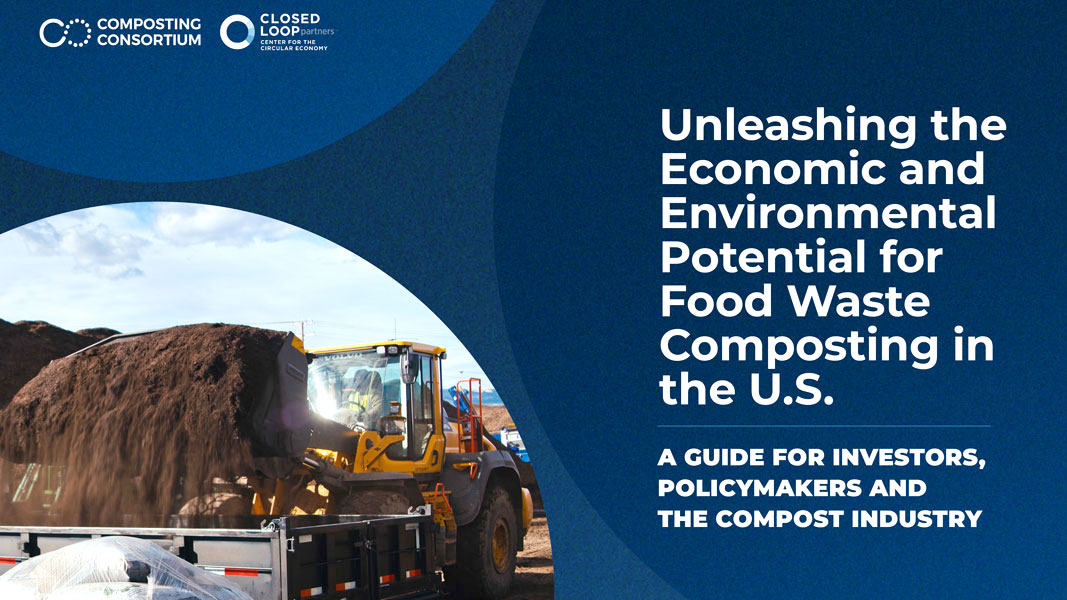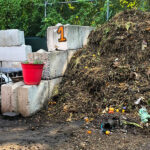Top: Image courtesy Closed Loop Partners
On July 17, the Composting Consortium, an initiative of Closed Loop Partners’ Center for the Circular Economy, released an incredibly useful and insightful roadmap for the composting industry: “Unleashing the Economic and Environmental Potential for Food Waste Composting in the U.S., A Guide For Investors, Policymakers And The Compost Industry.” Full disclosure: BioCycle editors Nora Goldstein and Craig Coker helped write the report, which utilizes data from 2023 BioCycle surveys of food waste composting infrastructure and residential food waste collection access in the U.S. But bias aside, this report serves as a robust economic and financial analysis of the current food waste composting playing field, and what is needed, investment-wise, to scale the country’s infrastructure.
Part I: Market Trends, Infrastructure and Collections, presents macro trends driving demand for food waste collection and composting infrastructure and what the current landscape is. Part 2: Composting 101, dives into the compost business model, discussing the diversity of models, the economics of running an operation (capital and operating expenditures, revenue sources) and compost end markets. A table on page 34 provides a detailed site footprint analysis for windrow, aerated static pile and in-vessel facility designs that help estimate acreage needed for a facility. Page 43 has a table reviewing barriers to compost market development; page 46 features a 4-quadrant figure that classifies compost end markets by traditional and emerging, and dollar and volume. For example, higher dollar traditional markets include landscaping, turf grass and organic agriculture; higher dollar emerging markets include storm water management, sports turf, and green roofs.
Part 3: Financing The Future Composting Industry, merges Closed Loop Partners’ insights as a circular economy investment firm with realities of compost facility financing, especially when it comes to expansion. Among key challenges to securing financing are permitting restrictions; capital intensity to establish greenfield, full-scale composting facilities; offtake agreements (e.g., securing long-term purchases for finished compost); lack of support for strategic expansions; and portfolio visibility. “Available project financing is typically looking for project portfolios that can absorb at least $20 million to $200 million,” explains the report. “This means that many composting developers need to secure or have visibility into securing sites, operators, permits and offtake agreements for a portfolio of this size before unlocking larger sources of capital — a practice that is atypical outside of a handful of multi-site operators, such as WM or Republic Services. Through our analysis, we have found that a blended financing framework can help to catalyze scale in existing composting infrastructure and bring traditional capital sources to the table.”
Within the blended capital framework, “various instruments play a crucial role” including grants and philanthropic funding for start-up capital that don’t typically require repayment, “patient and flexible” capital providers, typically known as impact investors, and private equity that has access to larger pools of capital (ventures, growth, buyout). Page 52 of the report ties these instruments together under the blended capital moniker, offering “a promising solution by strategically combining public and private capital, bringing together financing partners with different risk tolerances and return expectations. It can bridge the financing gap and propel composting infrastructure development.” For example, “public funds in blended finance act as a beacon for private investors, signaling strong market demand for composting infrastructure. Government investment shows a clear commitment to composting, boosting investor confidence.” Public funds or guarantees also can “act as a buffer, making composting facilities more attractive to private investors…in regions with uncertain tip fees, stricter environmental regulations or limited access to consistent feedstocks.”
These are just a few examples from the Composting Consortium’s easy-to-consume guide, which doesn’t get bogged down in finance industry jargon. “Unleashing the Economic and Environmental Potential for Food Waste Composting in the U.S.” can be downloaded at this link.













